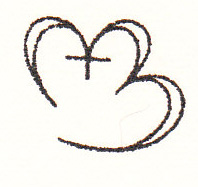Marat Zubar Studios was founded by my late birth-father, Marco S. Zubar., in 1959. Marco worked in several different artistic mediums and disciplines.
When he first came to the United States, in 1951, he studied architecture. As a student, he freelanced as a portrait painter. As his career in architecture grew, he only painted close friends and family. In 1959, he left the ecclesiastical architecture firm he’d been with for 5 years, Harold E. Wagoner and Associates. His intent was to pursue large scale commissions in the finer architectural crafts and painting.
His independent commissions began in stained glass. He focused on ecclesiastic monumental art (Judaic and Liturgical), and commercial stained glass for a decade. Eventually, being the consummate painter, his glass work evolved to include brush stroke imagery, achieved by applying resin to glass to shield it from sand blasting—allowing him to gently and fluidly etch the surface.
During the 1960’s he also explored large corten steel outdoor sculptures. You’ll see them in the website’s sculpture gallery. His Brutalist menorah with seven lamps is one of his most inspiring works.
His subject matter and themes were influenced by the iconography of his Ukrainian heritage. He was also influenced by surrealist 20th Century artists--Picasso, Chagall, and Salvador Dali.
In the early 1970s, Marco gravitated to ceramic mosaic wall murals--another virtually indestructible, outdoor-friendly, material. His murals allowed him to explore color and texture in a way that glass, lead, steel, and paint hadn’t.
In the early 1970s, Marco turned to ceramic mosaic. He mixed all his own glaze recipes from basic powdered ingredients, and tested their firing performance on thousands of cataloged test tiles. Crisscrossing glazes above and below one another, to determine how they interacted and their predictability once fired. He rolled-out the clay on a roller he’d built; rendered his own designs; cut out the tile shapes; built his on kiln (insulated in NASA material); anddouble-fired everything. He then reassembled and mounted them onto exterior-grade plywood backer panels. Marco assured me the tile pieces would retain their brilliance and strength even if they sat at the bottom of the sea for 100 years--as high fired ceramics sometimes do.
Marco’s ceramic glazes were known for his ‘reds’. Successfully producing an intense red glaze is difficult. Marco was able to achieve it. Note the red boots on the Saint Francis mural.
Enjoy!
Info
Please contact us via email. Proceed to "contact" page.
Links
https://www.philadelphiabuildings.org/pab/app/ar_display.cfm/756934
MZ Ceramic Notes-Winged Horse & Knight, April 18, 1983
Article-Marco Zubar to exhibit-Cultural Forum-Gallery of the Association of Ukrainian Artists, New York, as part of the millennium of Christianity in the Ukraine, in February, 1988.









